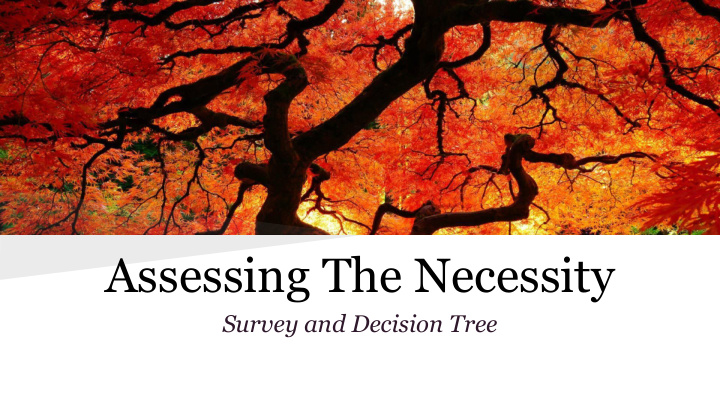



Assessing The Necessity Survey and Decision Tree
Activities Conducted ● Decision tree created December 2013. ● Survey closed March 5, 2014. ● 132 survey responses. 72 public health and 60 non-public health (NF, ALF, HCBS, other). ● Workgroup continued to work through decision tree and make decisions through consensus.
LT-101 Average Acuity by Program and PMPM - Nursing Home/SNF- SFY 2013 Average LT-101 Score for SNF= 20.4 Member Months=20,232 or 1,686 years PMPM=$3,867
LT-101 Average Acuity by Program and PMPM - LTC Waiver Average LT-101 for LTC Waiver =17.3 Member Months=16, 487 or 1,373.9 years PMPM=$1,677
LT-101 Average Acuity by Program and PMPM - ALF Waiver Average LT-101 for ALF Waiver =18.7 Member Months=1,743 or 145.25 years PMPM=$1,711
Begin Decision Tree Yes. SEA 82 (2013) specifically says “the department shall, to the extent practical, implement: A) Development of an assessment tool to replace the “Assessment of Medical Necessity for Long Term Care” required by W.S. 42-6- 102.
Decision Point 1 Q5 from survey Expanding the LT-101 to be used for other programs (Aging Division) only received 34% support and there was not great interest in the workgroup in using the assessment for other programs or populations at this time.
Decision Point 2 Question 5- Eligibility determination 83%, Appropriate level or location of care 71.5%, ID of support needs 82%, Informing support planning 46% (current process), Suggesting a plan of care 58.5% , Payment level for service 34%, Aging Division programs 34%
Decision Point 3 This was decided in early work group meetings and a workgroup pre-survey. 75% of workgroup responded that in- person was preferred.
Decision Point 4 Q3 Responses from survey ● 74.8% Public Health Nurses ● 8.4% State Contractor through RFP ● 3.8% Wyoming Medicaid ● 3.8% Facility Staff ● 5.3% Case Managers ● 3.8% Other (mix) Q4- Public Health Nurses were perceived to have lowest conflict of interest (8% of responses). Some counties with direct services were noted as exceptions. Q10- 94.6% thought the assessor should be conflict free and unrelated (financially and otherwise) to the outcome of the assessment
Decision Point 5 Q15- Nursing Home. Q17-ALF. Q18-PACE. Responses generally consistent with current schedule. Q16-LTC. 57.7% of non-public health preferred once a year or longer, 68% of public health preferred six months. Q19- Should the assessment schedule be the same? Yes 39.1%, No 46.1%, Don’t Know 14.8%
Beyond the Tree Additional Questions from the Survey
Decision Point 6 From Q6 Survey. Should the assessor be able to see the scoring? Overall- Yes 61% Among Public Health Nurses-Yes 69.5% All Others-Yes 50%
Decision Point 7 From Q7 Survey Who should be responsible for the final determination of whether a person meets the minimum medical necessity level for services? ● Assessor -- 38.4% ● State/Wyoming Medicaid staff-- 32% ● 3rd Party Contractor- 8.8% ● Electronic calculation or algorithm-- 20.8%
Decision Point 8 From Q9 Survey Which approach should Wyoming Medicaid take in replacing or altering the LT-101: (out of 5 choices) ● Modernize the LT-101- #1 choice of 69.5% ● Utilize Core Standardized Assessment Instrument promoted by CMS-#1 choice of 16.4%
Decision Point 9 Q13 I believe the assessment should be based on: ● ADLs - 99.24% ● General Safety- 91.7% ● Medications-83.3% ● Memory- 83.3% ● General Health Status- 81.8% ● Mental Health- 78% ● Nutrition-78% ● Health Conditions- 77.3%
Decision Point 9- Continued ● Communication Impairment- 73.5% ● Caregiver ability and availability-68.9% ● Required Therapies- 65.9% ● Sensory Function- 64.4% ● Social Resources- 56% ● Residential Living Environment- 51.5% ● Substance Abuse- 45.5% Some of these are not on the LT-101 currently. How should they be addressed (add-ons, supplementary questions, non-point questions)?
Recommend
More recommend